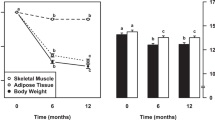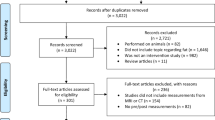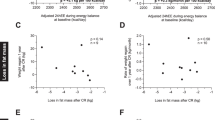Abstract
Background:
Although weight cycling is frequent in obese patients, the adverse consequences on body composition and an increased propensity to weight gain remain controversial.
Objective:
We investigated the effect of intentional weight loss and spontaneous regain on fat distribution, the composition of lean mass and resting energy expenditure (REE).
Design:
Weight regainers (⩾30% of loss, n=27) and weight-stable subjects (within <±20% of weight change, n=20) were selected from 103 overweight and obese subjects (body mass index 28–43 kg m−2, 24–45 years) who passed a 13-week low-calorie diet intervention. REE and body composition (by densitometry and whole-body magnetic resonance imaging) were examined at baseline, after weight loss and at 6 months of follow-up.
Results:
Mean weight loss was −12.3±3.3 kg in weight-stable subjects and −9.0±4.3 kg in weight regainers (P<0.01). Weight regain was incomplete, accounting for 83 and 42% of weight loss in women and men. Regain in total fat and different adipose tissue depots was in proportion to weight regain except for a higher regain in adipose tissue of the extremities in women and a lower regain in extremity and visceral adipose tissue in men. In both genders, regain in skeletal muscle of the trunk lagged behind skeletal muscle regain at the extremities. In contrast to weight-stable subjects, weight regainers showed a reduced REE adjusted for changes in organ and tissue masses after weight loss (P<0.001).
Conclusion:
Weight regain did not adversely affect body fat distribution. Weight loss-associated adaptations in REE may impair weight loss and contribute to weight regain.
This is a preview of subscription content, access via your institution
Access options
Subscribe to this journal
Receive 12 print issues and online access
$259.00 per year
only $21.58 per issue
Buy this article
- Purchase on Springer Link
- Instant access to full article PDF
Prices may be subject to local taxes which are calculated during checkout

Similar content being viewed by others
References
McGuire MT, Wing RR, Hill JO . The prevalence of weight loss maintenance among American adults. Int J Obes Relat Metab Disord 1999; 23: 1314–1319.
Lissner L, Odell PM, D‘Agostino RB, Stokes J, Kreger BE, Belanger AJ et al. Variability of body weight and health outcomes in the Framingham population. N Engl J Med 1991; 324: 1839–1844.
Lee IM, Paffenbarger RS . Change in body weight and longevity. JAMA 1992; 268: 2045–2049.
Blair SN, Shaten J, Brownell K, Collins G, Lissner L . Body weight change, all-cause mortality, and cause-specific mortality in the Multiple Risk Factor Intervention Trial. Ann Intern Med 1993; 119: 749–757.
Brownell KD, Rodin J . Medical, metabolic, and psychological effects of weight cycling. Arch Intern Med 1994; 154: 1325–1330.
Field AE, Malspeis S, Willett WC . Weight cycling and mortality among middle-aged or older women. Arch Intern Med 2009; 169: 881–886.
Benini ZL, Camilloni MA, Scordato C, Lezzi G, Savia G, Oriani G et al. Contribution of weight cycling to serum leptin in human obesity. Int J Obes Relat Metab Disord 2001; 25: 721–726.
Graci S, Izzo G, Savino S, Cattani L, Lezzi G, Berselli ME et al. Weight cycling and cardiovascular risk factors in obesity. Int J Obes Relat Metab Disord 2004; 28: 65–71.
Saarni SE, Rissanen A, Sarna S, Koskenvuo M, Kaprio J . Weight cycling of athletes and subsequent weight gain in middleage. Int J Obes (Lond) 2006; 30: 1639–1644.
Anastasiou CA, Yannakoulia M, Pirogianni V, Rapti G, Sidossis LS, Kavouras SA . Fitness and weight cycling in relation to body fat and insulin sensitivity in normal-weight young women. J Am Diet Assoc 2010; 110: 280–284.
Hamm P, Shekelle RB, Stamler J . Large fluctuations in body weight during young adulthood and twenty-five-year risk of coronary death in men. Am J Epidemiol 1989; 129: 312–318.
Olson MB, Kelsey SF, Bittner V, Reis SE, Reichek N, Handberg EM et al. Weight cycling and high-density lipoprotein cholesterol in women: evidence of an adverse effect: a report from the NHLBI-sponsored WISE study. Women’s Ischemia Syndrome Evaluation Study Group. J Am Coll Cardiol 2000; 36: 1565–1571.
Byrne NM, Weinsier RL, Hunter GR, Desmond R, Patterson MA, Darnell BE et al. Influence of distribution of lean body mass on resting metabolic rate after weight loss and weight regain: comparison of responses in white and black women. Am J Clin Nutr 2003; 77: 1368–1373.
Bosy-Westphal A, Kossel E, Goele K, Later W, Hitze B, Settler U et al. Contribution of individual organ mass loss to weight loss-associated decline in resting energy expenditure. Am J Clin Nutr 2009; 90: 993–1001.
Goele K, Bosy-Westphal A, Rumcker B, Lagerpusch M, Muller MJ . Influence of changes in body composition and adaptive thermogenesis on the difference between measured and predicted weight loss in obese women. Obes Facts 2009; 2: 105–109.
Keys A, Brozek J, Mickelsen O, Henschel A, Taylor H . The Biology of Human Starvation. University of Minnesota Press: Minneapolis, 1950.
Leibel RL, Hirsch J . Diminished energy requirements in reduced-obese patients. Metabolism 1984; 33: 164–170.
Leibel RL, Rosenbaum M, Hirsch J . Changes in energy expenditure resulting from altered body weight. N Engl J Med 1995; 332: 621–628.
de Boer JO, van Es AJ, Roovers LC, van Raaij JM, Hautvast JG . Adaptation of energy metabolism of overweight women to low-energy intake, studied with whole-body calorimeters. Am J Clin Nutr 1986; 44: 585–595.
Geissler CA, Miller DS, Shah M . The daily metabolic rate of the post-obese and the lean. Am J Clin Nutr 1987; 45: 914–920.
Weigle DS, Brunzell JD . Assessment of energy expenditure in ambulatory reduced-obese subjects by the techniques of weight stabilization and exogenous weight replacement. Int J Obes 1990; 14 (Suppl 1): 69–77.
Tremblay A, Chaput JP . Adaptive reduction in thermogenesis and resistance to lose fat in obese men. Br J Nutr 2009; 102: 488–492.
Jebb SA, Goldberg GR, Coward WA, Murgatroyd PR, Prentice AM . Effects of weight cycling caused by intermittent dieting on metabolic rate and body composition in obese women. Int J Obes 1991; 15: 367–374.
Wadden TA, Foster GD, Stunkard AJ, Conill AM . Effects of weight cycling on the resting energy expenditure and body composition of obese women. Int J Eat Disord 1996; 19: 5–12.
Beavers KM, Lyles MF, Davis CC, Wang X, Beavers DP, Nicklas BJ . Is lost lean mass from intentional weight loss recovered during weight regain in postmenopausal women? Am J Clin Nutr 2011; 94: 767–774.
Lee JS, Visser M, Tylavsky FA, Kritchevsky SB, Schwartz AV, Sahyoun N et al. Weight loss and regain and effects on body composition: the Health, Aging, and Body Composition Study. J Gerontol A Biol Sci Med Sci 2010; 65: 78–83.
Dulloo AG, Jacquet J, Montani JP . Pathways from weight fluctuations to metabolic diseases: focus on maladaptive thermogenesis during catch-up fat. Int J Obes Relat Metab Disord 2002; 26 (Suppl 2): S46–S57.
Rodin J, Radke-Sharpe N, Rebuffe-Scrive M, Greenwood MR . Weight cycling and fat distribution. Int J Obes 1990; 14: 303–310.
Wallner SJ, Luschnigg N, Schnedl WJ, Lahousen T, Sudi K, Crailsheim K et al. Body fat distribution of overweight females with a history of weight cycling. Int J Obes Relat Metab Disord 2004; 28: 1143–1148.
Zamboni M, Armellini F, Turcato E, Todisco P, Gallagher D, Dalle Grave R et al. Body fat distribution before and after weight gain in anorexia nervosa. Int J Obes Relat Metab Disord 1997; 21: 33–36.
Grinspoon S, Thomas L, Miller K, Pitts S, Herzog D, Klibanski A . Changes in regional fat redistribution and the effects of estrogen during spontaneous weight gain in women with anorexia nervosa. Am J Clin Nutr 2001; 73: 865–869.
Scalfi L, Polito A, Bianchi L, Marra M, Caldara A, Nicolai E et al. Body composition changes in patients with anorexia nervosa after complete weight recovery. Eur J Clin Nutr 2002; 56: 15–20.
Mayer L, Walsh BT, Pierson RN, Heymsfield SB, Gallagher D, Wang J et al. Body fat redistribution after weight gain in women with anorexia nervosa. Am J Clin Nutr 2005; 81: 1286–1291.
Hainer V, Kunesova M, Stich V, Parizkova J, Zak A, Stukavec V et al. Body-fat distribution and serum lipids during the long-term follow-up of obese patients treated initially with a very-low-calorie diet. Am J Clin Nutr 1992; 56: 283S–285S.
van der Kooy K, Leenen R, Seidell JC, Deurenberg P, Hautvast JG . Effect of a weight cycle on visceral fat accumulation. Am J Clin Nutr 1993; 58: 853–857.
Zamboni M, Armellini F, Turcato E, Micciolo R, Desideri S, Bergamo-Andreis IA et al. Effect of regain of body weight on regional body fat distribution: comparison between pre- and postmenopausal obese women. Obes Res 1996; 4: 555–560.
Lien LF, Haqq AM, Arlotto M, Slentz CA, Muehlbauer MJ, McMahon RL et al. The STEDMAN project: biophysical, biochemical and metabolic effects of a behavioral weight loss intervention during weight loss, maintenance, and regain. OMICS 2009; 13: 21–35.
Snyder WS, Cook MJ, Nasset ES, Karhausen RL, Howells GP, Tipton IH . Report of the Task Group on Reference Man. Pergamon Press: Oxford, UK, 1975.
Siri WE . Body composition from fluid spaces and density: analysis of methods 1961. Nutrition 1993; 9: 480–491.
Elia M . Organ and tissue contribution to metabolic rate. In Kinney JM, Tucker HN (eds) Energy Metabolism: Tissue Determinants and Cellular Corollaries. Raven: New York, 1992. pp 61–79.
Heymsfield SB, Gallagher D, Kotler DP, Wang Z, Allison DB, Heshka S . Body-size dependence of resting energy expenditure can be attributed to nonenergetic homogeneity of fat-free mass. Am J Physiol Endocrinol Metab 2002; 282: E132–E138.
Matthews DR, Hosker JP, Rudenski AS, Naylor BA, Treacher DF, Turner RC . Homeostasis model assessment: insulin resistance and beta-cell function from fasting plasma glucose and insulin concentrations in man. Diabetologia 1985; 28: 412–419.
Misra M, Soyka LA, Miller KK, Grinspoon S, Levitsky LL, Klibanski A . Regional body composition in adolescents with anorexia nervosa and changes with weight recovery. Am J Clin Nutr 2003; 77: 1361–1367.
Jackman MR, Steig A, Higgins JA, Johnson GC, Fleming-Elder BK, Bessesen DH et al. Weight regain after sustained weight reduction is accompanied by suppressed oxidation of dietary fat and adipocyte hyperplasia. Am J Physiol Regul Integr Comp Physiol 2008; 294: R1117–R1129.
Tchoukalova YD, Votruba SB, Tchkonia T, Giorgadze N, Kirkland JL, Jensen MD . Regional differences in cellular mechanisms of adipose tissue gain with overfeeding. Proc Natl Acad Sci USA 2010; 107: 18226–18231.
Singh P, Somers VK, Romero-Corral A, Sert-Kuniyoshi FH, Pusalavidyasagar S, Davison DE et al. Effects of weight gain and weight loss on regional fat distribution. Am J Clin Nutr 2012; 96: 229–233.
Froidevaux F, Schutz Y, Christin L, Jequier E . Energy expenditure in obese women before and during weight loss, after refeeding, and in the weight-relapse period. Am J Clin Nutr 1993; 57: 35–42.
Weyer C, Walford RL, Harper IT, Milner M, MacCallum T, Tataranni PA et al. Energy metabolism after 2 y of energy restriction: the biosphere 2 experiment. Am J Clin Nutr 2000; 72: 946–953.
Weyer C, Pratley RE, Salbe AD, Bogardus C, Ravussin E, Tataranni PA . Energy expenditure, fat oxidation, and body weight regulation: a study of metabolic adaptation to long-term weight change. J Clin Endocrinol Metab 2000; 85: 1087–1094.
Rosenbaum M, Hirsch J, Gallagher DA, Leibel RL . Long-term persistence of adaptive thermogenesis in subjects who have maintained a reduced body weight. Am J Clin Nutr 2008; 88: 906–912.
de Groot LC, van Es AJ, van Raaij JM, Vogt JE, Hautvast JG . Energy metabolism of overweight women 1 mo and 1 y after an 8-wk slimming period. Am J Clin Nutr 1990; 51: 578–583.
Astrup A, Buemann B, Christensen NJ, Madsen J . 24-hour energy expenditure and sympathetic activity in postobese women consuming a high-carbohydrate diet. Am J Physiol 1992; 262: E282–E288.
Amatruda JM, Statt MC, Welle SL . Total and resting energy expenditure in obese women reduced to ideal body weight. J Clin Invest 1993; 92: 1236–1242.
Weinsier RL, Hunter GR, Zuckerman PA, Redden DT, Darnell BE, Larson DE et al. Energy expenditure and free-living physical activity in black and white women: comparison before and after weight loss. Am J Clin Nutr 2000; 71: 1138–1146.
Acknowledgements
The study was funded by Deutsche Forschungsgemeinschaft (DFG Mü 714/ 8-3), BMBF Kompetenznetz Adipositas, core domain "Body Composition" (Körperzusammensetzung; FZ 01 GI 1125).
Author information
Authors and Affiliations
Corresponding author
Ethics declarations
Competing interests
The authors declare no conflict of interest.
Additional information
Author contributions
Study design (AB-W, MJM), MRI protocol (C-CG, MH), data collection (AB-W, KG), image segmentation (BS, WB, MP), data analyses (AB-W, ML), discussion of data and writing of the manuscript (AB-W, MJM).
Rights and permissions
About this article
Cite this article
Bosy-Westphal, A., Schautz, B., Lagerpusch, M. et al. Effect of weight loss and regain on adipose tissue distribution, composition of lean mass and resting energy expenditure in young overweight and obese adults. Int J Obes 37, 1371–1377 (2013). https://doi.org/10.1038/ijo.2013.1
Received:
Revised:
Accepted:
Published:
Issue Date:
DOI: https://doi.org/10.1038/ijo.2013.1
Keywords
This article is cited by
-
The Physiological Effects of Weight-Cycling: A Review of Current Evidence
Current Obesity Reports (2024)
-
Weight cycling based on altered immune microenvironment as a result of metaflammation
Nutrition & Metabolism (2023)
-
Total and regional appendicular skeletal muscle mass prediction from dual-energy X-ray absorptiometry body composition models
Scientific Reports (2023)
-
Cold exposure prevents fat accumulation in striped hamsters refed a high-fat diet following food restriction
BMC Zoology (2022)
-
Adaptive thermogenesis after moderate weight loss: magnitude and methodological issues
European Journal of Nutrition (2022)



